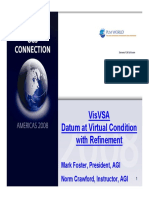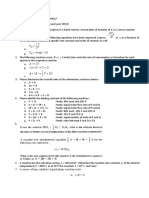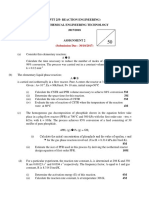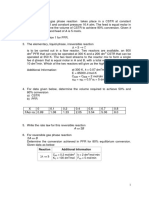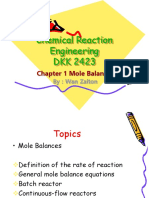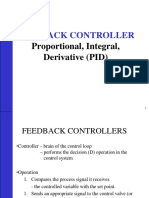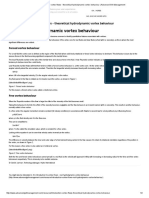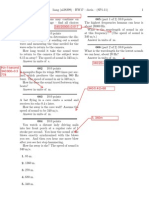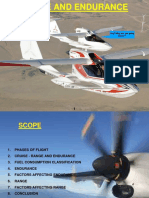Tutorial 2
Uploaded by
EreenTutorial 2
Uploaded by
EreenREACTION ENGINEERING 1 CHE502
TUTORIAL 2- Topic 2
1. What is a rate law? What factors affect the value of the rate constant for a given
reaction?
2. What are the units of the rate constant for (a) a first order reaction (b) second order
reaction
3. The rate law for a reaction was found to be
rate (2.35x106 L 2 mol 2 s 1 )A B
2
What would the rate of reaction be if:
a) The concentrations of A and B are 1.00 mol/L
b) [A]=0.25 M, [B]=1.30 M
4. For the decomposition of dinitrogen pentoxide, the following data were collected in
constant volume of batch reactor
2N 2O5 4NO2 O2
Concentration, (mol/L) Time (s)
5.00 0
3.52 500
2.48 1000
1.75 1500
1.23 2000
0.87 2500
0.61 3000
Determine the rate law of this decomposition reaction using differential (numerical)
method.
5. Consider the following reaction of 0.02M solution of limiting reactant bromine, and 0.2M
solution of formic acid of equal portion as follows:
Br2 (aq) + HCOOH (aq) 2H+ (aq) + 2Br-(aq) + CO2
REACTION ENGINEERING 1 CHE502
The concentration of bromine was measured experimentally at various times as
tabulated in table below:
Experimental data
Time(s) 0.2 1 2.2 3 4.3 5 7.5 10 15.5 20 25.7 30
Concentration
of bromine 1.00 0.91 0.83 0.75 0.68 0.63 0.49 0.39 0.25 0.15 0.10 0.06
(mmol/L)
Determine the rate law using integral method of data analysis.
6. The reaction
AB+C
was carried out in a constant volume batch reactor where the following concentration
measurements were recorded as a function of time
Time(s) 0 5 9 15 22 30 40 60
Concentration
2 1.6 1.35 1.1 0.87 0.70 0.53 0.35
(mol/dm3)
Use differential method to determine the reaction order, α and the specific reaction rate.
*Data from Problem P5-6B (Page 296 Fogler)
7. The reaction of NO with Cl2 follows the equation
2NO Cl 2 2NOCl
The following data were collected:
Initial NO (mol/L) Initial Cl2 (mol/L) Initial rate of NOCl (mol/L.s)
0.10 0.10 2.53 x 10-6
0.10 0.20 5.06 x 10-6
0.20 0.10 10.1 x 10-6
0.30 0.10 22.8 x 10-6
What is the rate law for the reaction?
8. The decomposition of C2H5Cl has the following rate law: Rate=k[C2H5Cl] at 550°C,
k=3.2x10-2s-1
a) What is the half life of this reaction at 550°C?
b) If the concentration of C2H5Cl is 0.010 M after 1 min, what was the initial
concentration of C2H5Cl?
You might also like
- Isothermal Reactor Design - With Audio - Part 1&2No ratings yetIsothermal Reactor Design - With Audio - Part 1&243 pages
- Assignment 1 CHE502/594 Reaction Engineering 1 Due Date: Monday (14 OF MAY 2018)No ratings yetAssignment 1 CHE502/594 Reaction Engineering 1 Due Date: Monday (14 OF MAY 2018)1 page
- (P01, C01, C02, C2, C3) : Confidential EH/JUN 2014/CHE584/594No ratings yet(P01, C01, C02, C2, C3) : Confidential EH/JUN 2014/CHE584/59411 pages
- CHME 314 Lecture 14 Collection and Analysis of Rate Data 2No ratings yetCHME 314 Lecture 14 Collection and Analysis of Rate Data 217 pages
- CEB2043 - Reaction Engineering I - Ch03 Rate Laws PDFNo ratings yetCEB2043 - Reaction Engineering I - Ch03 Rate Laws PDF25 pages
- For Student Test1 Version 3 SKKK1113 1112-1 PDFNo ratings yetFor Student Test1 Version 3 SKKK1113 1112-1 PDF3 pages
- Topic 1: Siti Wahidah Binti Puasa PHONE NO: 03-55436327 011-32338927 Reference: Fogler 4 Edition, Levenspeil 3 EditionNo ratings yetTopic 1: Siti Wahidah Binti Puasa PHONE NO: 03-55436327 011-32338927 Reference: Fogler 4 Edition, Levenspeil 3 Edition35 pages
- CHM 152 Final Exam Review 1 Spring 2012 NEW KEYNo ratings yetCHM 152 Final Exam Review 1 Spring 2012 NEW KEY4 pages
- Steady State Non-Isothermal Reactor DesignNo ratings yetSteady State Non-Isothermal Reactor Design34 pages
- Lec 1 - Fundamental Concepts, Force VectorsNo ratings yetLec 1 - Fundamental Concepts, Force Vectors66 pages
- Chemical Reaction Engineering (CHE 331A) Assignment-2 (2017-18-II)No ratings yetChemical Reaction Engineering (CHE 331A) Assignment-2 (2017-18-II)2 pages
- CHE3044F, 2013: Reactor Design 1: TUTORIAL 3No ratings yetCHE3044F, 2013: Reactor Design 1: TUTORIAL 33 pages
- CHFEN 3553 Chemical Reaction Engineering: April 28, 2003 1:00 PM - 3:00 PM Answer All QuestionsNo ratings yetCHFEN 3553 Chemical Reaction Engineering: April 28, 2003 1:00 PM - 3:00 PM Answer All Questions4 pages
- Chapter 3: Solid - Liquid Extraction / Leaching100% (3)Chapter 3: Solid - Liquid Extraction / Leaching47 pages
- Feedback Controller: Proportional, Integral, Derivative (PID)100% (1)Feedback Controller: Proportional, Integral, Derivative (PID)34 pages
- An Introduction To Vortex Ows - Theoretical Hydrodynamic Vortex BehaviourNo ratings yetAn Introduction To Vortex Ows - Theoretical Hydrodynamic Vortex Behaviour2 pages
- Chapter 1 - Introduction To Project Management100% (1)Chapter 1 - Introduction To Project Management88 pages
- LAB 04 Mini Launcher: Experiment 1: OutlineNo ratings yetLAB 04 Mini Launcher: Experiment 1: Outline9 pages
- Manual Acrylite Injection Molding Brochure100% (1)Manual Acrylite Injection Molding Brochure36 pages
- Gabriel Lugo - 2020 - Differential Geometry in Physics - V3 - OK - 11-08-2020 (4684)No ratings yetGabriel Lugo - 2020 - Differential Geometry in Physics - V3 - OK - 11-08-2020 (4684)233 pages
- II PU Maths All District Preparatory QPs 2024No ratings yetII PU Maths All District Preparatory QPs 2024153 pages
- University of California Berkeley Physics Problems With Solutions0% (1)University of California Berkeley Physics Problems With Solutions25 pages
- Anodic Dissolution of Pure Aluminum During Electrocoagulation Process - Influence of Supporting Electrolyte, Initial PH, and Current Density PDF100% (1)Anodic Dissolution of Pure Aluminum During Electrocoagulation Process - Influence of Supporting Electrolyte, Initial PH, and Current Density PDF12 pages
- Derivation of The Bree Diagram: Problem: A Body Is Subject To A Constant Uniaxial Primary Membrane StressNo ratings yetDerivation of The Bree Diagram: Problem: A Body Is Subject To A Constant Uniaxial Primary Membrane Stress22 pages
- McCool-DEVELOPMENT OF A PLUG ASSISTED THERMOFROMING SIMULATION-PaperNo ratings yetMcCool-DEVELOPMENT OF A PLUG ASSISTED THERMOFROMING SIMULATION-Paper4 pages
- Metallurgy & File Classification: Capital EndodonticsNo ratings yetMetallurgy & File Classification: Capital Endodontics26 pages
- The Banach-Tarski Paradox: Zaichen Lu October 2009No ratings yetThe Banach-Tarski Paradox: Zaichen Lu October 200910 pages
- ECE Renewable Energy Technology SyllabusNo ratings yetECE Renewable Energy Technology Syllabus5 pages

